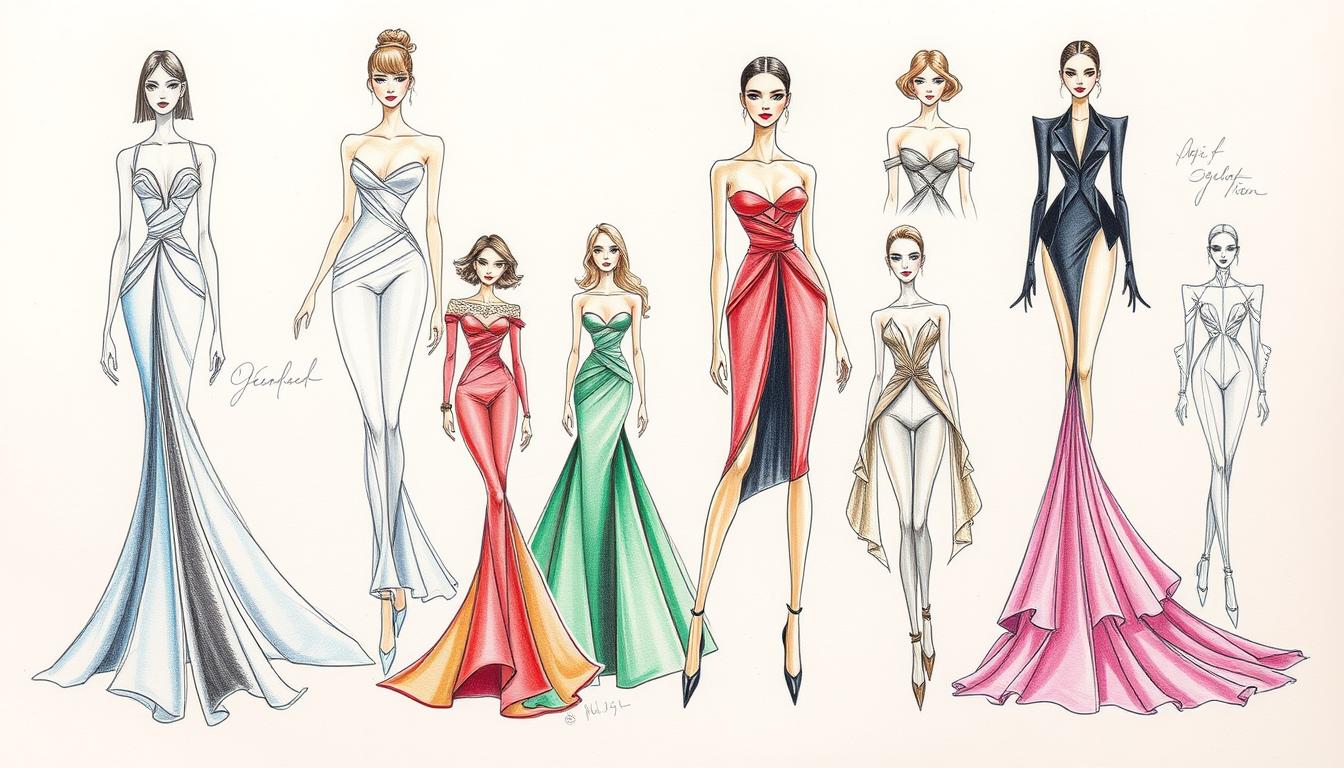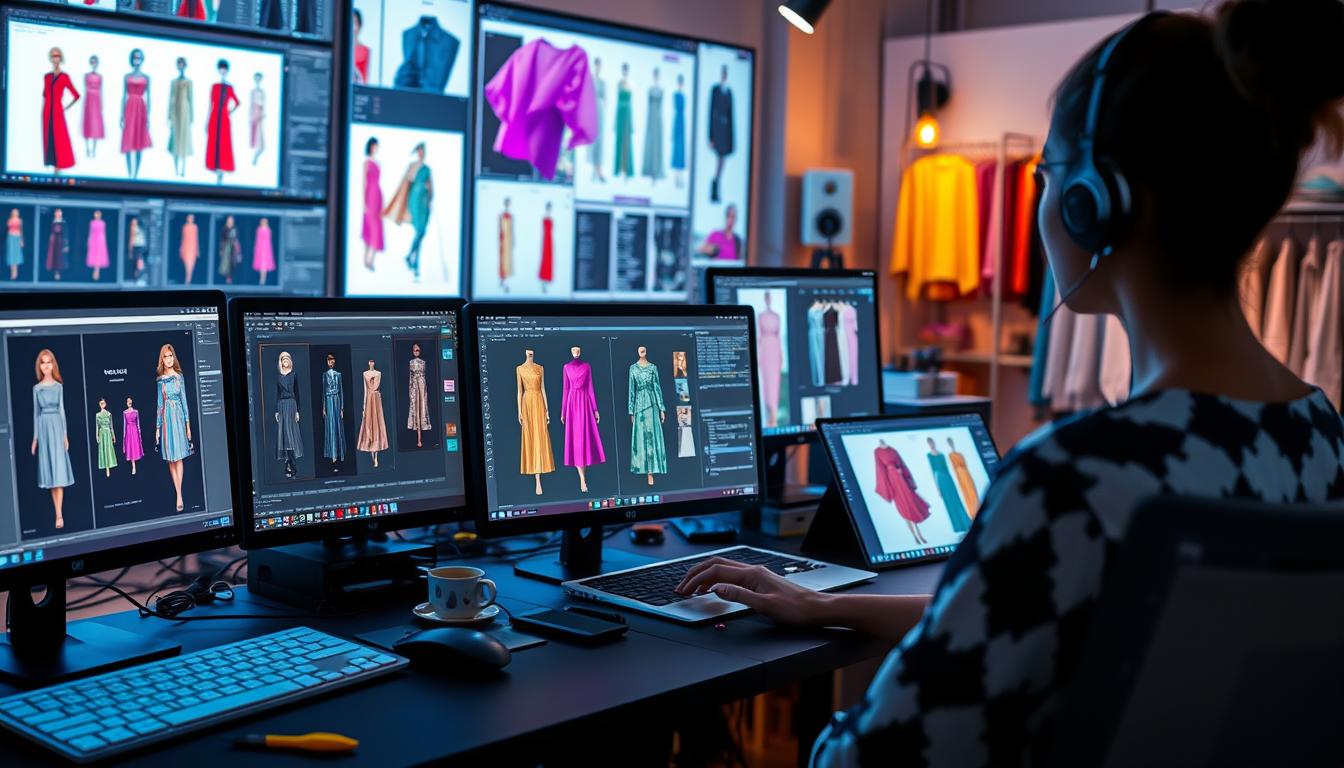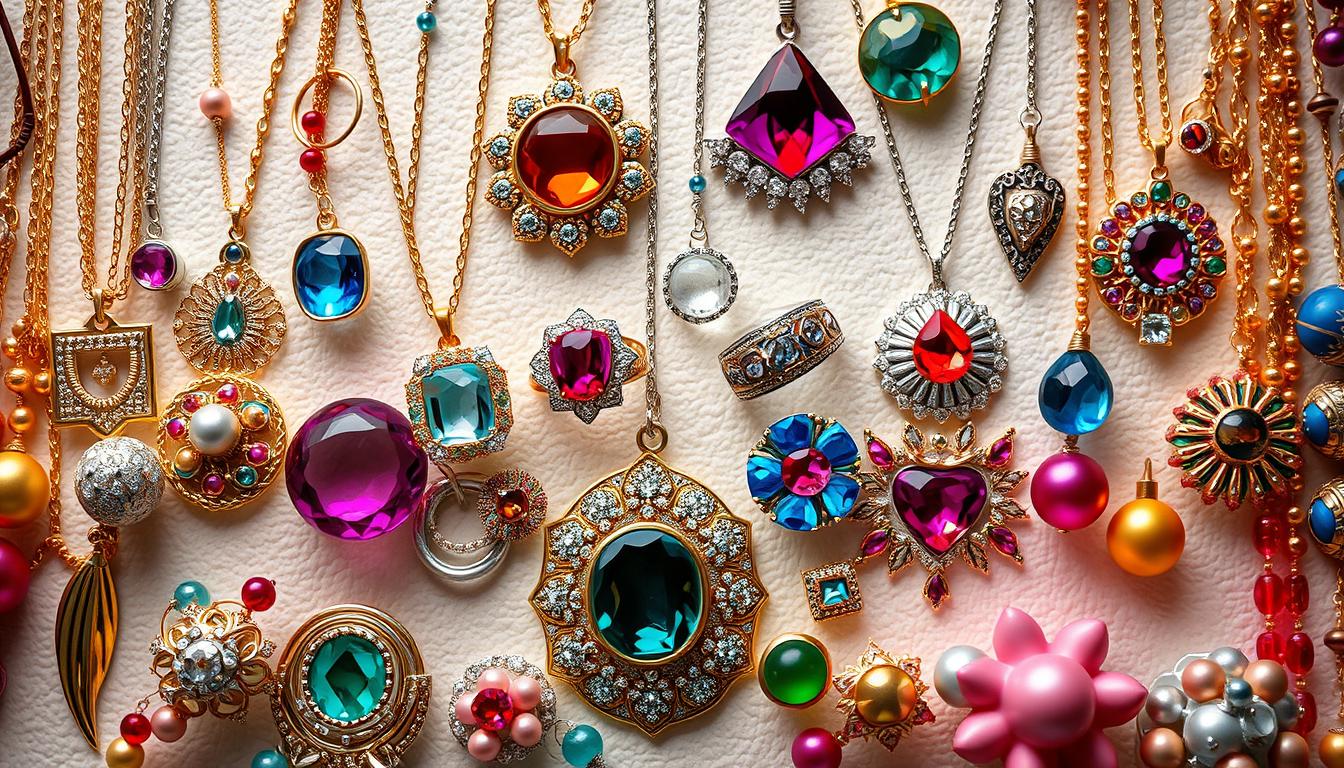In the world of fashion, sketches are like a canvas for designers. They are not just technical drawings. They show the creativity and essence of high fashion and runway trends. These sketches help designers share their ideas with tech pack designers, making sure every detail is clear.
Designers use sketches to try out shapes and patterns. They also decide on trims and embellishments. Sketches are key in the design process. They help designers turn their ideas into real designs and guide the making of their collections.
Key Takeaways
- Fashion design sketches are the foundation for visualizing and expressing style ideas in the industry.
- Sketches serve as a communication tool between creative designers and tech pack specialists.
- They enable designers to experiment with silhouettes, patterns, and trims before finalizing the design.
- Sketches play a vital role in translating the designer’s vision into concrete garment specifications.
- Sketching is an essential skill for fashion designers to cultivate their creative expression.
Understanding the Importance of Fashion Design Sketches
Fashion design sketches are key in the fashion world. They let designers show their creative ideas. These simple drawings turn ideas into real clothes. Everyone from big brands to new designers needs to know how to sketch well.
What are Fashion Design Sketches?
Fashion design sketches are the first look at style ideas. They can be simple drawings or detailed pictures. Designers use them to try out different shapes and colors. This helps them create their runway mood boards and final designs.
The Role of Sketches in the Design Process
Sketches are vital in fashion design. They help designers:
- See and share their ideas clearly
- Try out different designs
- Work with others to improve their ideas
- Show their designs for feedback
- Guide the making of clothes
Many see sketching as a must-have skill for designers. It’s important from the start to the final show. Sketches are a key tool in fashion design.
“Nothing can replace a fashion design sketchbook for drafting design ideas. Sketching allows designers to experiment with different ideas and colors, which is essential for creativity.”
| Software Usage | Adobe Illustrator is a popular choice for digital fashion design sketching. |
|---|---|
| Software Choices | Other software options include Digital Fashion Pro, Sketch, Procreate, and CorelDRAW for digital sketching. |
| Digital Transition | Transitioning from paper to digital sketching has become increasingly common in the industry. |
| Digital Sketching Techniques | Designers are encouraged to experiment with different brush styles and textures for unique effects. |
Sources of Inspiration for Fashion Sketches
Fashion designers always look for new ideas to spark their creativity. They find inspiration in nature, historical fashion, and even art movements. These sources help shape their fashion illustrations.
Nature as an Inspiration
The natural world is full of inspiration for designers. Plants, animals, and landscapes offer stunning patterns and colors. These elements often inspire their fashion sketches.
Historical Fashion Trends
Looking back at fashion history can spark new ideas. Designers love to mix old styles with new twists. This way, they create fresh looks in their sketches.
Art Movements and Their Influence
Art has always inspired fashion designers. Impressionism and cubism, for example, can change how they see fashion. These styles add unique touches to their sketches.
Designers find inspiration everywhere. From nature to art, they explore many sources. This diversity helps them create unique fashion sketches.

“Fashion is not something that exists in dresses only. Fashion is in the sky, in the street, fashion has to do with ideas, the way we live, what is happening.”
– Coco Chanel
Essential Tools for Creating Fashion Sketches
Fashion designers choose their tools carefully. These tools greatly affect the quality of their moodboards and artwork. The fashion world has many tools, both old and new.
Digital vs. Traditional Sketching Tools
Digital tools like Adobe Illustrator and CorelDraw are key for many designers. They make precise drawings and allow for easy changes. But, some designers love the feel of paper and pencils.
Recommended Fashion Illustration Software
- Adobe Illustrator: A powerful vector-based software widely used in the fashion industry for technical drawings, flat sketches, and digital illustrations.
- Procreate: A versatile digital painting and sketching app, particularly well-suited for fashion designers working on the iPad.
- Photoshop: Although primarily known for photo editing, Photoshop’s extensive brushes and layers make it a great choice for fashion sketches and design mockups.
- CorelDRAW: A comprehensive vector graphics suite that offers advanced features for technical fashion illustrations and garment pattern design.
Choosing between digital and traditional tools depends on personal taste and project needs. Many designers mix both, using digital for speed and traditional for unique looks.
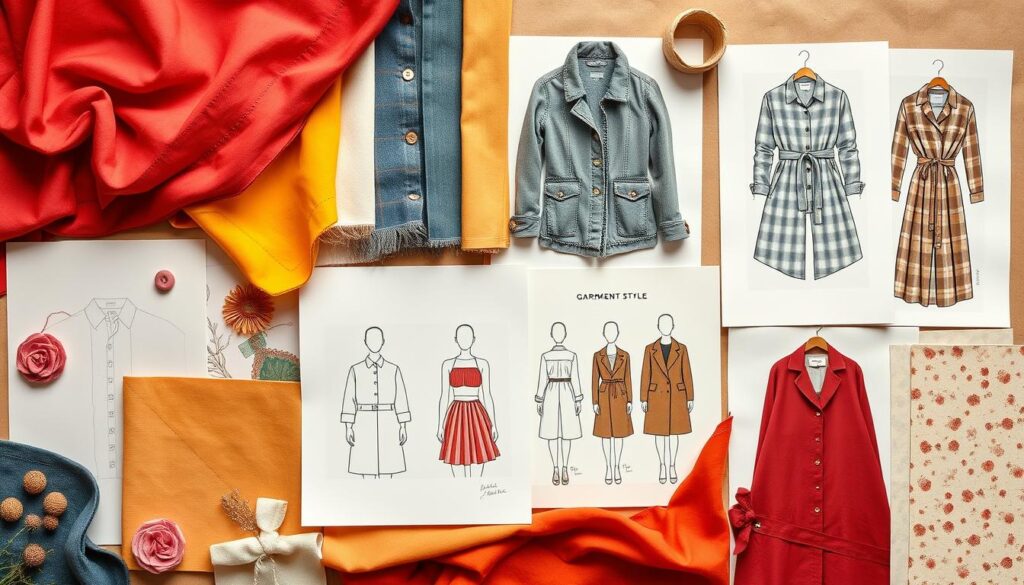
“Fashion sketching is not just about creating beautiful illustrations; it’s a process of exploration, problem-solving, and bringing ideas to life.” – Jane Doe, renowned fashion illustrator
Exploring Different Sketching Techniques
Fashion sketching is an art form that lets designers turn their ideas into real illustrations. The journey to create these designs involves many sketching techniques. From quick gesture drawings to detailed croquis studies, each has its own role in the design process.
Gesture Drawing for Fashion
Gesture drawing is fast and captures the essence of a pose or movement. It’s great for fashion designers to jot down ideas quickly. These sketches are loose and focus on the overall shape and energy of the figure, not details.
Learning gesture drawing helps designers explore many ideas fast. It lets them refine their ideas before making more detailed sketches.
Croquis and Figure Proportions
Croquis, or basic figure drawings, are templates for fashion designs. Knowing proper figure proportions is key for these sketches. It ensures the body shapes in designs are consistent and realistic.
Designers can choose between stylized or naturalistic croquis, based on their style and project needs. These sketches are the base for adding garment details and other design elements that make fashion sketches come alive.
Fashion sketching is a flexible and creative art form. Designers often develop their own styles and techniques. By trying different methods, like gesture drawing and croquis, designers can grow their creative skills and meet industry demands.
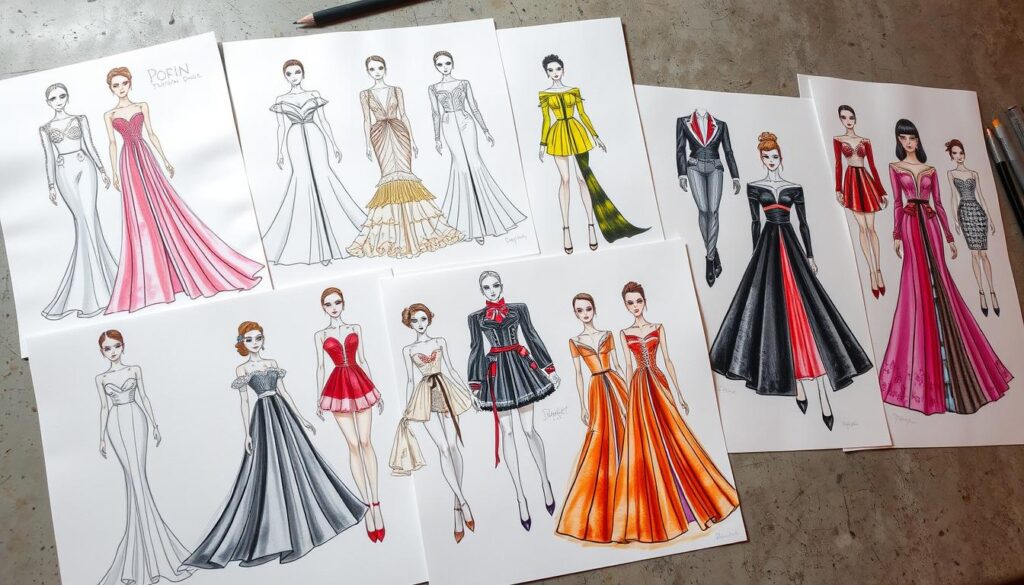
Color Theory in Fashion Design Sketches
Color theory is key in fashion design sketches. It helps designers use color wheels and hue relationships. This unlocks a world of possibilities for expressing their designs.
Understanding Color Wheels
The color wheel shows how colors are connected. It has primary colors (red, blue, yellow), secondary colors (orange, green, purple), and tertiary colors. Knowing the color wheel lets designers play with colors and understand their effects.
How to Choose the Right Color Palettes
Picking the right color palette is important. Designers must think about trends, audience, and the design’s mood. Using color relationships like complementary or analogous schemes can make designs stand out.
| Color Scheme | Percentage of Examples | Description |
|---|---|---|
| Monochromatic | 71% | Focus on various shades and tones of a single hue |
| Analogous | 29% | Use of adjacent colors on the color wheel |
Understanding color theory and trying different palettes can make designs pop. This way, designers can create stunning catwalk sketches and mood boards that grab attention.
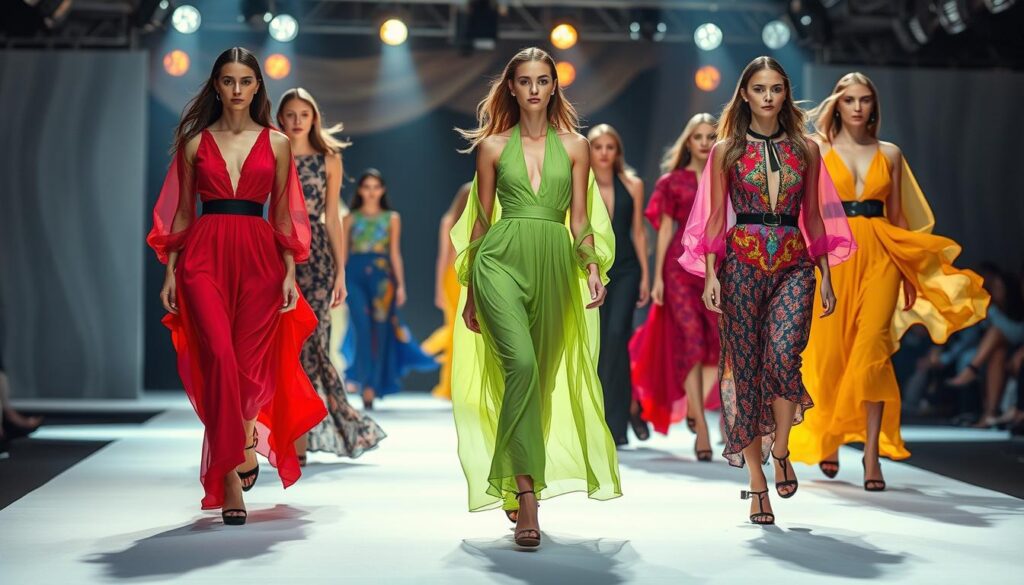
“Color is to the eye what music is to the ear.”
– Louis Comfort Tiffany
Using color wisely in sketches can evoke emotions and set a collection’s tone. It’s a key skill for designers to stand out in the fashion world.
Creating a Mood Board for Sketch Inspiration
In the world of fashion design, mood boards are key for collecting and organizing ideas. They help designers share their vision with teams and stakeholders. These visual collages are like a bridge, connecting ideas and bringing them to life.
Components of a Successful Mood Board
Old-school mood boards used magazine cutouts, fabric, and more. Now, digital tools like Pinterest and Canva make it easy to create virtual ones. A good mood board has images, colors, and fonts that show the designer’s vision.
Online Platforms for Mood Board Creation
- Repsketch
- Adobe Express
- Fotor
- Canva
- Milanote
These online tools make creating mood boards simple. Milanote, for instance, has over 100 free templates. It also lets you get feedback in real-time, making teamwork easier.
Good mood boards are essential in design. They keep the focus on the brand and evoke the right feelings. Whether digital or physical, they guide the design process.
Innovating with Fashion Sketch Styles
Fashion sketch styles have changed a lot over time. Designers now use many techniques to show their ideas. They go from simple designs to detailed ones, showing off patterns and textures.
Minimalist Designs
Minimalist sketches focus on clean lines and simple shapes. They show the design’s main points clearly. This style is great for showing a design’s simplicity and elegance.
Detailed and Realistic Illustrations
Designers also make detailed sketches. These show every part of the garment, like patterns and details. They help in making sure designs turn into real clothes without mistakes.
Abstract Representation in Fashion
Some designers use abstract sketches. These can have weird shapes or use new materials. They show the designer’s unique view of fashion.
Illustrators keep finding new ways to show fashion. They use many styles, from simple to detailed. This shows the creativity and variety in fashion.
“The future of fashion design lies in the fusion of traditional techniques and cutting-edge technology. As designers, we must embrace innovation to push the boundaries of what’s possible.” – Manaza Ishaque, Fashion Illustrator
Designers use many tools to make vogue illustrator portfolios and garment style moodboards. They try different styles to find their own voice. This way, they meet the needs of their clients and the fashion world.
Collaborating with Other Creatives
Collaboration is key in the fashion world. Designers, artists, and visionaries team up to create stunning collections. This teamwork leads to fresh ideas and exciting designs.
Benefits of Team Sketching Sessions
Team sketching brings together different creative minds. This mix leads to more detailed and appealing designs. It also allows for sharing ideas and solving problems together.
Networking Opportunities in Fashion Design
The fashion world is all about connections. Events, workshops, and online groups help designers meet others. These meetings can lead to new ideas, feedback, and even career chances.
Collaboration opens up new creative paths for designers. It’s about working together, from sketching to networking. This teamwork is essential for creating amazing fashion collections.
| Type of Collaboration | Benefits |
|---|---|
| Production Partnerships | Outsourcing design and production, allowing brands to focus on research, branding, and selling. |
| Licensing Agreements | Enabling testing of designs in new markets without significant capital investment. |
| Retail Collaborations | Showcasing multiple brands in one location, helping to test new collections and build brand awareness. |
| Brand-specific Marketing Campaigns | Involving joint advertising or marketing efforts to reach broader audiences. |
| Marketing Partnerships | Investments in another company’s products or services, e.g., launching a line together or influencer marketing. |
Good communication is crucial in teamwork. It helps everyone understand their roles and work together smoothly. Tools like TUKAcloud make virtual collaboration easier by helping with design, organization, and planning.
Examples like Elsa Schiaparelli and Salvador Dalí’s work in the 1930s show the power of fashion and art together. The 2021 team-up between Lawrence Weiner, Virgil Abloh, and Louis Vuitton, and the 2023 project with TOMS and Frida Kahlo are also inspiring.
Collaboration is key for designers to explore new ideas and create amazing collections.
Showcasing Your Sketches Effectively
As a fashion designer, it’s key to show off your haute couture illustrations and catwalk sketch ideas well. Social media and online portfolios are great for sharing your work with people all over the world. They help you show off your design skills.
Social Media Platforms for Designers
Instagram, Pinterest, and Behance are great for fashion designers to share their sketches. When you post your work, use the right hashtags, write detailed captions, and talk to your followers. This helps you build a strong online presence.
Building an Online Portfolio
Having a professional online portfolio is important. It lets you show off your best sketches and design process in a neat way. Think about the quality of your images, how you present them, and what you write about them. Your portfolio should show off your artistic talent and design sense.
| Platform | Benefits |
|---|---|
| Visually-driven platform to share haute couture illustrations and catwalk sketch ideas | |
| Mood board-style platform to curate and showcase fashion design inspiration | |
| Behance | Showcase your design work, including fashion sketches, in a professional portfolio |
When you show off your sketches, pay attention to the details. Make sure your images are clear, your presentations are nice to look at, and your descriptions get across what your designs are about. By using social media and online portfolios, you can get more people to see your work and connect with others in the fashion world.
Overcoming Creative Blocks
As fashion designers, we all hit creative blocks sometimes. These blocks can stop the flow of ideas, making it hard to create mood boards or designs. But, with the right methods and a regular sketching habit, you can beat these blocks and get back to designing.
Techniques to Spark Inspiration
When creativity dries up, it’s time to find new sources of inspiration. Step away from your desk and explore nature. Its calm and natural shapes can spark your creativity. Also, dive into fashion history and art movements to see things from new angles.
Cultivating a Daily Sketching Habit
Regular practice keeps creativity flowing. Set aside time each day for sketching. It could be quick drawings or trying out new styles. This habit sharpens your skills and keeps your mind ready for design.
Remember, beating creative blocks is a journey. By using these tips, you’ll find new inspiration and improve your sketches. Your designs will wow your audience and take your career to new levels.
Learning from Established Fashion Designers
Studying famous fashion designers can give new creatives great insights and inspiration. Looking at the sketches of iconic couturiers lets us see their design process. It shows us their techniques, styles, and artistic ways that have changed fashion.
Studying Iconic Designers’ Sketches
Looking at the sketches of legends like Coco Chanel, Christian Dior, and Yves Saint Laurent is very helpful. Chanel’s sketches show simple elegance, while Dior’s are full of drama. Each designer’s style shows their unique vision and artistic feelings. By studying these, designers can find their own way to sketch.
Analyzing the Evolution of Fashion Sketches
Fashion sketching has changed a lot, just like the trends, tech, and tastes in the industry. Seeing how fashion illustration has moved from hand-drawn to digital can teach a lot. It shows how fashion design has grown and changed. This helps designers find new ways to create.

